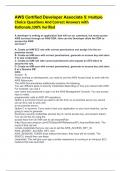Exam (elaborations)
AWS Certified Developer Associate 5: Multiple Choice Questions And Correct Answers with Rationale,100% Verified
- Course
- Institution
AWS Certified Developer Associate 5: Multiple Choice Questions And Correct Answers with Rationale,100% Verified A developer is writing an application that will run on -premises, but must access AWS services through an AWS SDK. How can the Developer allow the SDK to access the AWS services? A...
[Show more]



